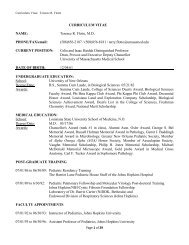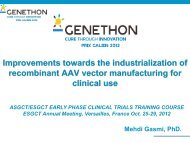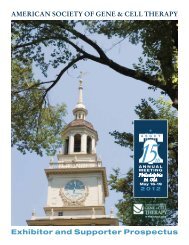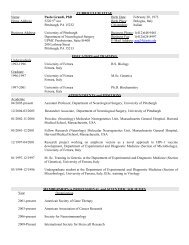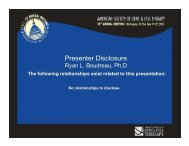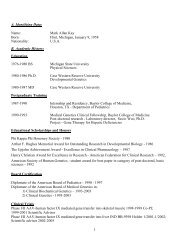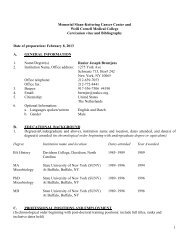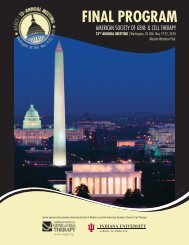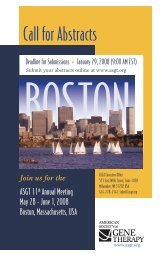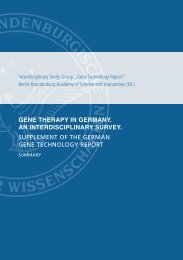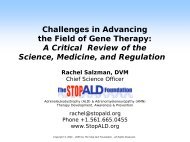Neurologic & Ophthalmic - American Society of Gene & Cell Therapy
Neurologic & Ophthalmic - American Society of Gene & Cell Therapy
Neurologic & Ophthalmic - American Society of Gene & Cell Therapy
Create successful ePaper yourself
Turn your PDF publications into a flip-book with our unique Google optimized e-Paper software.
<strong>Neurologic</strong> & <strong>Ophthalmic</strong> <strong>Gene</strong> & <strong>Cell</strong> <strong>Therapy</strong><br />
Summary by Anne Messer, PhD<br />
<strong>Gene</strong> and <strong>Cell</strong> Therapies for Auditory and Olfactory Disorders<br />
Co-Chairs: Jodi L. McBride, PhD and Anne Messer, PhD<br />
<strong>Gene</strong> and cell therapies for auditory and olfactory disorders are promising approaches for<br />
human therapeutics. Although the field is relatively new, a combination <strong>of</strong> genetic and<br />
environmental perturbations in humans can be modeled sufficiently to optimize<br />
parameters, and establish pro<strong>of</strong> <strong>of</strong> concept to move the most promising corrections<br />
forward clinically.<br />
Jeffrey Holt, PhD, gave an excellent introduction to the auditory system, and the sensory<br />
transduction process, including dysfunctions. His lab is particularly focused on the<br />
tension-controlled calcium channels, TMC1 and 2. Tmc1 is expressed in hair cells, and<br />
knockout mice have been produced to mimic a genetic disorder that causes deafness in<br />
humans. <strong>Gene</strong> replacement in vitro demonstrated rescue <strong>of</strong> function. In vivo work with<br />
AAV1 is in progress. The availability <strong>of</strong> TMC2 knockouts (which appear to primarily<br />
affect the vestibular system) and double knockouts provides additional opportunities to<br />
model, understand, and correct this critical set <strong>of</strong> pathways in the auditory system.<br />
Larry Lustig, MD, presented AAV1-mediated restoration <strong>of</strong> hearing in vesicular<br />
glutamate transporter 3 (VGLUT3) knockout mice. The acoustic brainstem response can<br />
be fully corrected, and the readily-measured startle response is partially corrected. Dr.<br />
Lustig presented data on several parameters that affect the degree and persistence <strong>of</strong><br />
correction, including viral titer, route <strong>of</strong> administration, and age <strong>of</strong> treatment. P1<br />
treatment was the most effective and long-lasting. Round window membrane delivery <strong>of</strong><br />
virus appears to be as effective as a cochleostomy at this early age <strong>of</strong> delivery.<br />
The third presentation on auditory correction strategies described cell, rather than gene,<br />
therapy. Marcelo Rivolta, MD, starts with human embryonic stem cells (hESCs), which<br />
can be directed to otic epithelial or otic neuronal progenitors, using FGF3 or FGF10.<br />
The former further differentiate with tissue signals as hair or ganglion cells, while the<br />
latter form only the ganglion neurons. When transplanted into a gerbil deafness model,<br />
the cells can survive and form functional connections <strong>of</strong>fering partial correction.<br />
Olfaction is another sensory organ that is vulnerable to genetic and environmental<br />
damage, with some severe effects on safety and nutrition. Jeffrey Martens presented<br />
studies using adenovirus to correct the cilliary protein IFT88 in olfactory sensory<br />
neurons. Delivery <strong>of</strong> this gene into knockout mice improved their feeding behavior and<br />
body weights, via transduction <strong>of</strong> mature neurons. This general approach is applicable to<br />
multiple important ciliated cell types.
The variety <strong>of</strong> targets and approaches covered by the speakers illustrate the strong<br />
potential for gene and cell therapy to impact a wide range <strong>of</strong> human sensory disorders.



